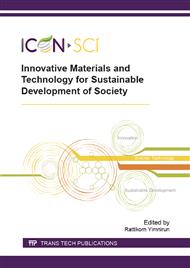p.279
p.283
p.287
p.291
p.295
p.299
p.304
p.311
p.316
The Difference of Si/Al Ratio on Organo-Zeolite in the Adsorption of Atrazine and Linuron
Abstract:
Linuron and atrazine as a kind of pesticides were used more widely in agriculture. The toxic effect in the environments, which accumulation in soil, water and human effect. Both of pesticides were adsorped using zeolites with batch method. Three difference types of zeolite were used for comparison. Those pesticides consisted of various Si/Al ratio which were 3.61 (Y), 8.61 (Y-10) and 111.35 (Y-100). The organo-zeolite, which modified with hexadecyltrimethyl ammonium (HDTMA) surfactant were used for comparison. It was found that the adsorption capacity of linuron more than atrazine 30 % for Y , 40 % for Y-10 and 10 % for Y-100. It can be explaned that the small molecules of linuron (thickness 6.12 Ao) could move onto pore size of zeolite (7.4 Ao). While the larger molecules of atrazine (thickness 9.6 Ao) could not do this. The maximum asorption capacities of all pesticides are Y-100 and MY-100 because they have most external area and hydrophobic properties which were form their most dealuminative potential. The comparison of MY-10 and Y-10 found that MY-10 has more adsorption capacities than Y-10 as follow 4 % for linuron and 20 % for atrazine since MY-10 has more increased hydrophobic force. Adsorption capacity of MY-100 is similar to Y-100. Adsorption capacities of MY is lower than Y since it has steric effect and pore blocked with surfactant. This results were identified by XRF, XRD, FT-IR, TGA and CHNS.
Info:
Periodical:
Pages:
295-298
Citation:
Online since:
October 2015
Authors:
Keywords:
Price:
Сopyright:
© 2015 Trans Tech Publications Ltd. All Rights Reserved
Share:
Citation:


